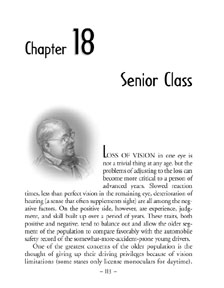 |
| Vision loss may present unique challenges to older generations. In this chapter, Mr. Brady describes these challenges and offers several responses. "Loss of vision in one eye is not a trivial thing at any age, but the problems of adjusting to the loss can become more critical to a person of advanced years. Slowed reaction time, less than perfect vision in the remaining eye, deterioration of hearing, a sense that often supplements sight, are negative factors. On the positive side are experience, judgment and skill built up over a period of years. These attributes, both positive and negative tend to balance out and allow the older segment of the population to compare favorably with the automobile safety record of the somewhat more accident prone youthful drivers." (pg. 125) "Most important--periodic eye examinations, yearly if possible, to catch the onset of problems such as glaucoma and cataracts in their early stages and to keep eye glass prescriptions up to date. . .glaucoma, if detected in it's early stage, can be arrested and with continuing treatment, vision can be retained." (pg. 126) Chapter 1. An Unhappy Landing Chapter 2. An Awkward Takeoff Chapter 3. Jolts of Reality Chapter 4. Flying High Chapter 5. How About You? Chapter 6. Seeing in 3-D—How It Works Chapter 7. What Has Changed? Chapter 8. Getting Back to 3-D Chapter 9. Avoiding Problems and Possible Mistakes Chapter 10. In the Driver’s Seat Chapter 11. The Active Life Chapter 12. Let Technology Help Chapter 13. Keeping the Good Eye Good Chapter 14. Seeing to Your Looks Chapter 15. Eye-making (Ocularistry) Chapter 16. Driving and Piloting Licenses Chapter 17. For Parents Only Chapter 18. Senior Class Chapter 19. In Good Company Glossary Resources |